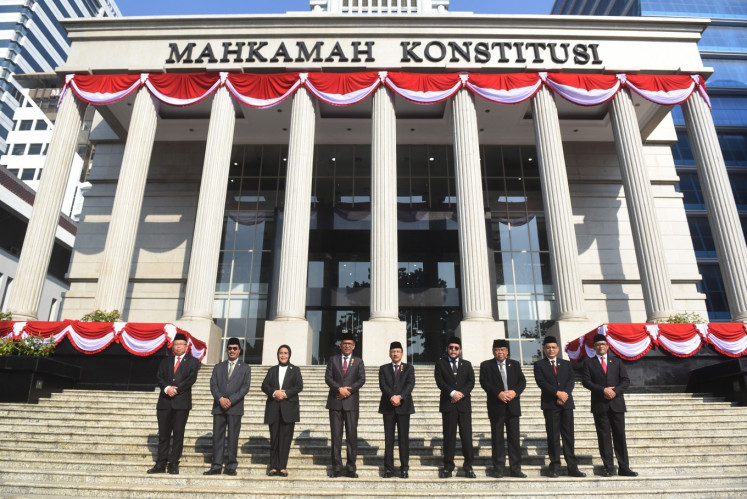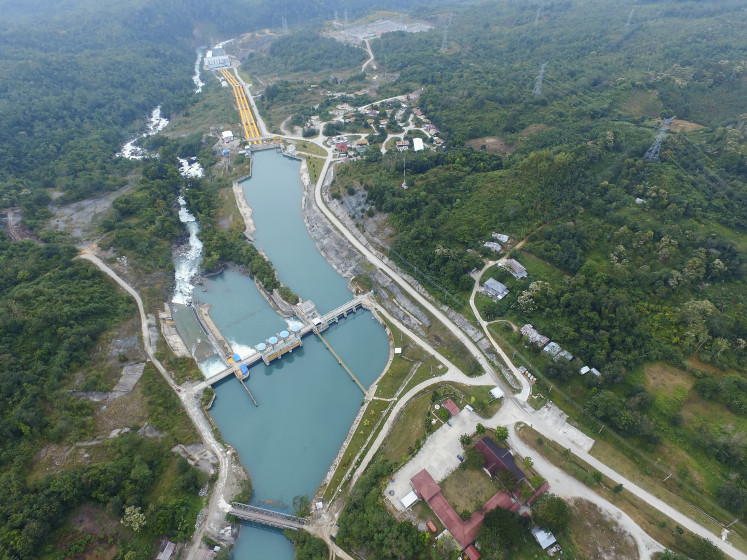Popular Reads
Top Results
Can't find what you're looking for?
View all search resultsPopular Reads
Top Results
Can't find what you're looking for?
View all search resultsFighting graft: No (unlawful) gain without pain
Corruption has been a global pandemic and has caused massive financial losses that severely affect the economy
Change text size
Gift Premium Articles
to Anyone

C
orruption has been a global pandemic and has caused massive financial losses that severely affect the economy. In Indonesia, a single case involving a public official may cost the country millions of dollars of tax payers' money.
According to a report by the Supreme Audit Agency (BPK) in 2011, for example, it was estimated that the potential losses from the misuse of public funds in Indonesia was in excess of Rp 103 trillion (US$10.9 billion). With its devastating effects to the economy, many believe that without corruption, the level of poverty in Indonesia would have been much lower than what it is today.
In other words, corruptors are often blamed in particular for the low quality of life of poorer people. This happens because corruption essentially strips away the very resources that could be used to make lives better.
The lavish lifestyle of corruptors had at the expense of society's well-being has raised issues on how severe their punishment should be. Recently, the Supreme Court heightened the jail sentence handed down to former House of Representative's member and beauty queen Angelina Sondakh to 12 years from a previous 4.5 years for her involvement in an athlete's village graft case.
In addition, Angelina is also required to pay a Rp 500-million fine and nearly Rp 40 billion in restitution.
Several other graft convicts have also seen their prison sentences and fines increased by the Supreme Court. In the most recent graft trial, former Prosperous Justice Party (PKS) leader Luthfi Hasan Ishaaq received 16 years in prison for his role in an illegal beef import scheme.
When Angelina was sentenced to 4.5 years in prison by the high court, many believed the punishment was not harsh enough to sufficiently deter future offenders, and thus the Corruption Eradication Commission (KPK) appealed the sentence.
Theoretically, a graft offender must be punished according to the severity of his or her offense. The problem is that accurately deciding the level of harshness for graft offenders is anything but easy.
Many disagreements exist regarding how to quantify punishment so as to provide the appropriate amount of harshness to the offenders. Even for financial punishments such as fines and restitution, disagreements still exist as to their measurement.
During the course of forensic auditing, calculating state losses from corruption as a basis for determining, among other things, restitution is a challenge in itself.
This is because corruption is by nature concealed from the eyes of the authorities and the public. The concealed nature of the offense makes calculating total losses accurately very difficult if not impossible.
To overcome this problem, in some parts of loss calculation, 'estimation' may be used rather than 'measurement' of the actual figures.
Anti-corruption experts believe that to calculate the total losses from corruption, forensic auditors need to be able to identify the corrupt acts, the victims and the types and amount of losses borne by the victims.
The total losses from corruption are simply the sum of all the losses suffered by all the victims. Although such an equation appears simple, in practice, gathering and calculating the data can be a daunting task even for experienced forensic auditors.
Recently, I was a speaker in a focus group discussion (FGD) organized by the Center for the Study of Economic Crime at the Indonesian Islamic University (UII) in Yogyakarta to discuss various issues connected to the calculation of fines for corruption offenders.
From the discussion, it can be concluded that we certainly need agreed upon technical procedures to decide the amount of fine that will be imposed on corruption offenders. Some believe that the cost of the investigation should be part of the basis for calculating fines for offenders.
This argument is due to the fact that fraud investigation can be resource consuming, as a huge amount of taxpayer money is spent to bring offenders to justice. Another basis for this argument is that from the 'consequentialism' perspective, punishment for fraud offenders must benefit society in the future.
There are several things that constitute the high cost of a forensic audit. In principal, unlike the financial audit, when it comes to a forensic audit, the only certain thing is uncertainty. Additionally, in high-profile fraud cases, there will also be attempts from offenders to hinder the investigation by using their power to complicate the investigation procedures and thus increase the cost of the investigation.
Throughout the course of a forensic audit, auditors will face various challenges, many of which can be unexpected. In the 'predication' stage of a forensic audit where auditors need to decide whether or not they must initiate the audit,
for example, their ability to predict the occurrence of fraud will be put to the test.
This is so since, despite the existing preliminary data, there is no certain formula to know whether or not fraud has actually occurred or will occur.
Experts believe that in this process auditors should not rely only on financial data but instead they should also consider other non-financial symptoms such as individual or organizational behavior. An extravagant lifestyle, for example, is the most observable behavioral symptom of fraud offenders all over the globe.
Another example is that organizations with a high level of social dominance orientation (SDO) are generally more prone to committing corruption. Whistle-blowing can also be an important consideration in the predication stage of a forensic audit. In fact, studies suggest that 'tips' are the most common way corruption is detected in the first place.
Nevertheless, it is worth noting that despite auditors' best efforts, there is no guarantee that every forensic audit will result in corruption being uncovered, as in some cases unintended errors are the real cause of the problems.
Due to the high cost of a forensic audit, despite the inevitable uncertainty, auditors, especially those working for the government, need to plan their audit carefully so as to not waste their resources.
Effective and efficient forensic audits will provide greater deterrence to discourage potential corruption offenders from ever becoming full-fledged corruptors in the future.
_______________________
The writer, who obtained his masters and PhD in forensic accounting from the University of Wollongong Australia, is director of the Center for Forensic Accounting Studies in the accounting program of the Indonesian Islamic University (UII), Yogyakarta.









